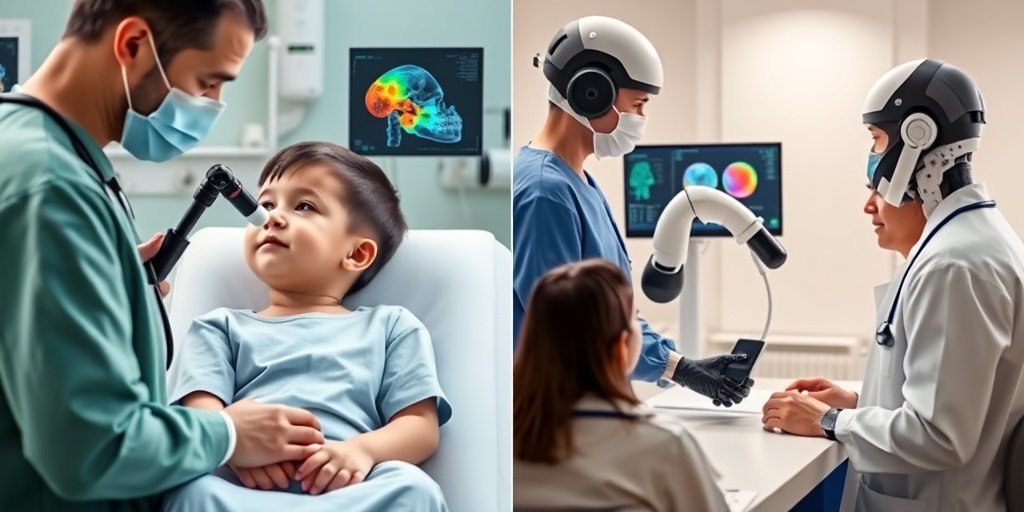⚡ Quick Summary
This review highlights the critical advancements in the management of airway foreign body aspiration, particularly in children and older adults. Key findings include a 98-99% sensitivity for detecting radiopaque objects using multidetector computed tomography and an 87% success rate for flexible bronchoscopy in pediatric cases.
🔍 Key Details
- 👶 Affected Populations: Primarily children under 5 years and adults over 65 years.
- 🧪 Diagnostic Tools: Multidetector computed tomography with 3D reconstruction.
- ⚙️ Therapeutic Modalities: Flexible bronchoscopy as a first-line treatment.
- 🏆 Success Rates: 87% in pediatric cases; comparable outcomes in adults.
- 🔧 Advanced Technologies: Robotic-assisted bronchoscopy and AI-powered imaging analysis.
🔑 Key Takeaways
- 📊 Diagnostic Accuracy: Multidetector CT achieves 98-99% sensitivity for radiopaque objects.
- 💡 Flexible Bronchoscopy: Evolved into a primary therapeutic option with high success rates.
- 🏥 Rigid Bronchoscopy: Remains superior for large or sharp foreign bodies.
- 🤖 Technological Innovations: Robotic systems and AI enhance procedural safety and precision.
- 🌍 Multidisciplinary Approach: Essential for effective management of airway foreign bodies.
- 📈 Preprocedural Planning: Critical for successful outcomes and complication management.
- 🆕 Emerging Practices: Integration of advanced imaging and telemedicine consultations.

📚 Background
Airway foreign body aspiration is a serious medical emergency that can lead to significant morbidity and mortality, especially in vulnerable populations such as young children and the elderly. Understanding the latest diagnostic and therapeutic strategies is crucial for healthcare providers to effectively manage these cases and improve patient outcomes.
🗒️ Study
This review synthesizes current evidence on the management of airway foreign bodies, focusing on diagnostic strategies, bronchoscopic techniques, and the integration of emerging technologies. The authors emphasize the importance of a tailored, multidisciplinary approach that considers the patient’s clinical status and the characteristics of the foreign body.
📈 Results
The findings indicate that multidetector computed tomography significantly enhances diagnostic accuracy, achieving a sensitivity of 98-99% for radiopaque objects and 85-92% for radiolucent materials. Flexible bronchoscopy has shown an 87% success rate in pediatric cases, while rigid bronchoscopy remains the preferred method for more complex presentations.
🌍 Impact and Implications
The advancements in airway foreign body management have profound implications for clinical practice. By adopting a multidisciplinary approach and utilizing cutting-edge technologies, healthcare providers can enhance the safety and efficacy of procedures. This not only improves patient outcomes but also reduces the risk of complications associated with foreign body aspiration.
🔮 Conclusion
The review underscores the importance of individualized care in managing airway foreign bodies. With the integration of advanced imaging techniques and innovative bronchoscopic methods, healthcare professionals are better equipped to handle these emergencies. Continued research and development in this field are essential for further improving patient care and outcomes.
💬 Your comments
What are your thoughts on the advancements in airway foreign body management? We would love to hear your insights! 💬 Share your comments below or connect with us on social media:
Foreign body removal.
Abstract
PURPOSE OF REVIEW: Airway foreign body aspiration remains a potentially life-threatening emergency, predominantly affecting children under 5 years and adults over 65 years. This review synthesizes current evidence on diagnostic strategies, bronchoscopic extraction techniques, procedural outcomes, complication management, and emerging technologies in airway foreign body management.
RECENT FINDINGS: Multidetector computed tomography with three-dimensional reconstruction has significantly improved diagnostic accuracy, achieving sensitivity of 98-99% for radiopaque objects and 85-92% for radiolucent materials. Flexible bronchoscopy has evolved from a diagnostic tool to a first-line therapeutic modality, with recent pediatric meta-analyses demonstrating 87% success rates and adult series showing comparable outcomes to rigid bronchoscopy for appropriately selected cases. Rigid bronchoscopy maintains superiority in asphyxiating presentations, and for large (>1.5 cm), sharp, or severely impacted foreign bodies. Technological innovations including robotic-assisted bronchoscopy, electromagnetic navigation systems, and artificial intelligence-powered imaging analysis are enhancing procedural precision and safety.
SUMMARY: Successful airway foreign body management requires individualized, multidisciplinary approaches integrating patient clinical status, foreign body characteristics, and institutional expertise. Success depends on appropriate bronchoscopic modality selection, comprehensive preprocedural planning, availability of specialized retrieval instruments, and readiness to manage potential complications. Integration of advanced imaging, simulation-based training protocols, and telemedicine consultation are becoming essential components of contemporary practice.
Author: [‘Goyal R’, ‘Sehgal IS’, ‘Agarwal R’]
Journal: Curr Opin Pulm Med
Citation: Goyal R, et al. Foreign body removal. Foreign body removal. 2025; (unknown volume):(unknown pages). doi: 10.1097/MCP.0000000000001225